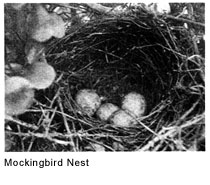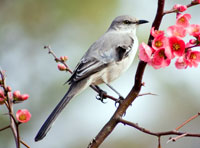|

Northern Mockingbird: The Northern Mockingbird, Mimus polyglottos, is the only mockingbird commonly found in North America. The Northern Mockingbird breeds in southeastern Canada, the United States, northern Mexico, the Bahamas, Cayman Islands and the Greater Antilles. It is replaced further south by its close relative, the Tropical Mockingbird, Mimus gilvus.
 Nest and Territory: Nest and Territory:
The Northern Mockingbird builds a twig nest in a dense shrub or tree, which it aggressively defends against other birds and animals, including humans.
When a predator is persistent, Mockingbirds from neighboring territories, summoned by a distinct call, may join the attack.
Other birds may gather to watch as the Mockingbirds harass the intruder. This bird is mainly a permanent resident, but northern birds may move south during harsh weather. This species has occurred in Europe as an extreme rarity.
On the Hunt: These birds forage on the ground or in vegetation; they also fly down from a perch to capture food. They mainly eat insects, berries and seeds. While foraging they frequently spread their wings in a peculiar two-step motion to display the white patches. The purpose of this behavior is disputed. Some ornithologists say this is purely a territorial display, while others say that flashing the white patches startles hiding insects and forces them into the open.
 Annoying Neighbor: Mockingbirds' willingness to nest near houses, loud and frequent songs, and territorial defense often annoy people. John van der Linden, the author of the Eastern Birding Central FAQ, says that 25 to 50 percent of the e-mail questions he receives are about how to deal with annoying mockingbirds. Annoying Neighbor: Mockingbirds' willingness to nest near houses, loud and frequent songs, and territorial defense often annoy people. John van der Linden, the author of the Eastern Birding Central FAQ, says that 25 to 50 percent of the e-mail questions he receives are about how to deal with annoying mockingbirds.
Barons in the Trees: Mockingbirds have a strong preference for certain trees such as maple, sweetgum, and sycamore. They generally avoid pine trees after the other trees have grown their leaves. Also, they have a particular preference for high places, such as the topmost branches of trees.
City Birds:
Mockingbirds are often found in urban and suburban areas, where they perch on telephone poles, streetlights, or high points on buildings. While singing on a high perch they will often bolt several feet into the air in a looping motion, with wings outstretched to display their white underside, then land back on the perch without breaking a note. That serves as a territorial display.

There are 17 species in four genera.
Genus Melanotis
-------
Blue Mockingbird Melanotis caerulescens
-------
Blue-and-white Mockingbird Melanotis hypoleucus
Genus Mimodes
------- Socorro Mockingbird Mimodes graysoni
Genus Mimus
------- Brown-backed Mockingbird Mimus dorsalis
-------
Tropical Mockingbird Mimus gilvus
-------
Bahama Mockingbird Mimus gundlachii
-------
Long-tailed Mockingbird Mimus longicaudatus
-------
Large-billed Mockingbird Mimus magnirostris
-------
Patagonian Mockingbird Mimus patagonicus
-------
Northern Mockingbird Mimus polyglottos
-------
Chalk-browed Mockingbird Mimus saturninus
-------
Chilean Mockingbird Mimus thenca
-------
White-banded Mockingbird Mimus triuris
Genus Nesomimus (Galápagos Islands)
------- Española Mockingbird Nesomimus mcdonaldi
-------
San Cristóbal Mockingbird Nesomimus melanotis
-------
Galápagos Mockingbird Nesomimus parvulus
-------
Floreana Mockingbird Nesomimus trifasciatus (extremely rare)
Genetic tests have shown that mockingbirds are most closely related to starlings.

All text is available under the terms
of the GNU Free Documentation License |